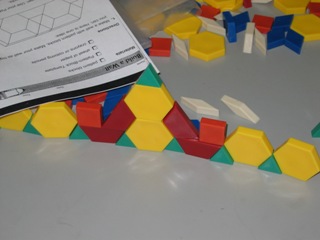Students sometimes find the set model of fractions harder to understand and use. These problems were designed to help students concretely work with the set model to solve problems.
Let's look at a sample problem:
 Mrs. Puglisi’s third graders visited the park nature center to see the tadpoles and
Mrs. Puglisi’s third graders visited the park nature center to see the tadpoles and frogs. They counted 20 animals in the tank.
• 3/4 of the animals had already changed to frogs.
• The rest were still tadpoles.
• How many frogs were in the tank?
• How many tadpoles were in the tank?
• Explain how you know your answers are correct.
Concretely Solving the Problem:
- Students should begin by counting out 20 manipulative objects they will use to solve the problem.
- Next, students look at the fraction 3/4. The denominator tells us that the animals were divided into 4 groups. NOTE: It is often helpful to use a piece of paper that is folded into quarters so that students may sort the manipulatives evenly into each of the 4 spaces.
- Students deal out the manipulatives as if they were cards, placing one in each of the 4 spaces and repeating until all of the manipulatives have been distributed.
- Students check to make sure that each quarter has the same number of animals.
- Now students look back at the fraction 3/4. The denominator of 4 told students how many groups. The numerator of 3 in this case tells students how many of the groups had already changed to frogs.
- Students count the total number of frogs in 3 groups.
- The other group are still tadpoles. Students count how many animals are still tadpoles.
- Finally, students may use words, pictures and numbers to record their thinking and explain how they knew their answer was correct.
Extension: After students have mastered this concrete approach to solving fraction problems using the set model, they may move to a paper-and-pencil semi-concrete solution method.
- The student draws a square on his paper.
- He checks the denominator of the fraction to see how many groups are needed. The student divides the square into that many identical parts.
- The student then makes dots or tally marks in each section, as above, dividing the total number of objects evenly among the groups.
- The student checks the numerator of the fraction to see how many groups he must label for his answer.
- NOTE: The beauty of this method is that students may easily use this approach in standardized testing situations. It's completely portable!
- Students may also simply draw four circles to represent the 4 groups and proceed as above.
Practice Problems:
- Tadpoles and Frogs requires students to use fractions to figure out how many tadpoles and frogs there were in the tank.
- Animal Shelter requires students to use fractions to figure out how many cats and dogs were available for adoption at the animal shelter.
- Ask students to write original problems, peer solve and edit, then add to your classroom collection for future use.






